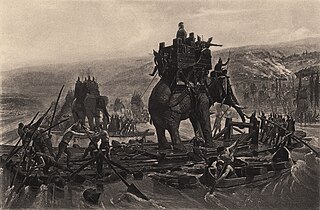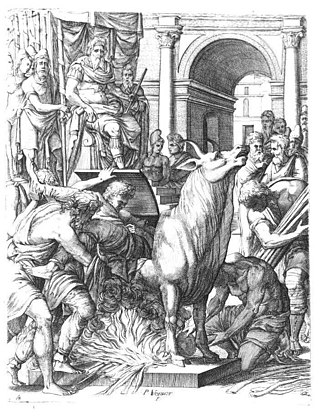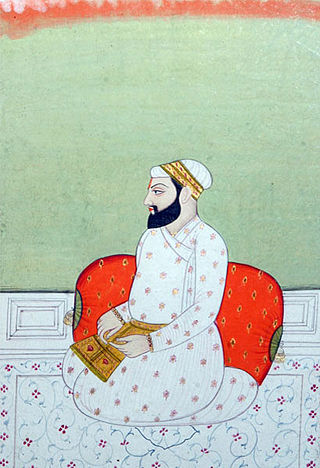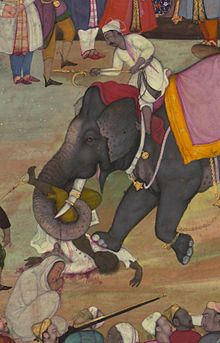
The breaking wheel, also known as the execution wheel, the Wheel of Catherine or the (Saint) Catherine('s) Wheel, was a torture method used for public execution primarily in Europe from antiquity through the Middle Ages up to the 19th century by breaking the bones of a criminal or bludgeoning them to death. The practice was abolished in Bavaria in 1813 and in the Electorate of Hesse in 1836: the last known execution by the "Wheel" took place in Prussia in 1841. In the Holy Roman Empire it was a "mirror punishment" for highwaymen and street thieves, and was set out in the Sachsenspiegel for murder, and arson that resulted in fatalities.
Death by crushing or pressing is a method of execution that has a history during which the techniques used varied greatly from place to place, generally involving placing heavy weights upon a person with the intent to kill.

A war elephant was an elephant that was trained and guided by humans for combat. The war elephant's main use was to charge the enemy, break their ranks, and instill terror and fear. Elephantry is a term for specific military units using elephant-mounted troops.

Guru Hargobind was the sixth of ten Gurus of the Sikh religion. He had become Guru at the young age of eleven, after the execution of his father, Guru Arjan, by the Mughal emperor Jahangir.

Dismemberment is the act of completely disconnecting and or removing the limbs from a living or dead being. It has been practiced upon human beings as a form of capital punishment, especially in connection with regicide, but can occur as a result of a traumatic accident, or in connection with murder, suicide, or cannibalism. As opposed to surgical amputation of limbs, dismemberment is often fatal. In criminology, a distinction is made between offensive dismemberment, in which dismemberment is the primary objective of the dismemberer, and defensive dismemberment, in which the motivation is to destroy evidence.
3 Maccabees, also called the Third Book of Maccabees, is a book written in Koine Greek, likely in the 1st century BC in either the late Ptolemaic period of Egypt or in early Roman Egypt. Despite the title, the book has nothing to do with the Maccabean Revolt against the Seleucid Empire described in 1 Maccabees and 2 Maccabees. Instead it tells the story of a persecution of the Jews under Pharaoh Ptolemy IV Philopator in Ptolemaic Egypt, some decades before the Maccabee uprising in Judea. The story purports to explain the origin of a Purim-like festival celebrated in Egypt. 3 Maccabees is somewhat similar to the Book of Esther, another book which describes how a king is advised to annihilate the Diaspora Jews in his territory, yet is thwarted by God.

Farrukhsiyar, also spelled as Farrukh Siyar, was the tenth Mughal Emperor from 1713 to 1719. He rose to the throne after deposing his uncle Jahandar Shah. He was an emperor only in name, with all effective power in the hands of the courtier Sayyid brothers.

The Battle of Karnal was a decisive victory for Nader Shah, the founder of the Afsharid dynasty of Iran, during his invasion of India. Nader's forces defeated the army of Muhammad Shah within three hours, paving the way for the Iranian sack of Delhi. The engagement is considered the crowning jewel in Nader's military career as well as a tactical masterpiece. The battle took place near Karnal in Haryana, 110 kilometres (68 mi) north of Delhi, India.

The Battle of the Bagradas River was fought between a Carthaginian army led by Hamilcar Barca and a rebel force led by Spendius in 240 BC in what is now north-east Tunisia. Carthage was fighting a coalition of mutinous soldiers and rebellious African cities in the Mercenary War, which had started late the previous year in the wake of the First Punic War. The rebels were blockading Carthage and besieging the northern ports of Utica and Hippo. A Carthaginian army commanded by Hanno had attempted and failed to relieve Utica early in 240 BC. A second army was assembled in Carthage and entrusted to Hamilcar, who had commanded Carthaginian forces on Sicily for the last six years of the First Punic War.

The Battle of the Saw was the culminating battle of a campaign fought between a Carthaginian army led by Hamilcar Barca and a rebel force led by Spendius in 238 BC in what is now northern Tunisia. Carthage was fighting a coalition of mutinous soldiers and rebellious African cities in the Mercenary War which had started in 241 BC. The rebels had been besieging Carthage while the Carthaginian field army under Hamilcar raided their supply lines. Under this pressure the rebels pulled back to their base at Tunis and despatched their own army to prevent Hamilcar's activities and, ideally, destroy his army.

War elephants were used in Iranian military history, most notably in Achaemenid, Seleucid, and Sasanian periods. These were Asian elephants recruited from the southern provinces of Iran and India, but also possibly Syrian elephants from Syria and western Iran.

Bandi Chhor Divas is a Sikh celebration commemorating the day the sixth Guru of Sikhs, Guru Hargobind and 52 Hindu Kings were released from Gwalior Fort, who had been imprisoned by Mughal Emperor Jahangir. Emperor Jahangir had held 52 Kings at the Gwalior Fort for several months. Gurdwara Data Bandi Chhor Sahib is located at the place of the Guru's internment in the Fort. The day falls in autumn and often overlaps with Hindu Diwali, the festival of lights celebrated across Punjab and the rest of India. Historically, from the time of the third Sikh Guru Amar Das, Sikhs and Hindus of the time used the occasion of Diwali, Vaisakhi and other such festivals to congregate at the seat of the Gurus. In 2003, Sikh religious leaders and the Shiromani Gurdwara Parbandhak Committee led by Prof. Kirpal Singh Badungar formally adopted this day into the Nanakshahi calendar.

The brazen bull, also known as the bronze bull, Sicilian bull, or bull of Phalaris, was an alleged torture and execution device designed in ancient Greece. According to Diodorus Siculus, recounting the story in Bibliotheca historica, Perilaus (Περίλαος) of Athens invented and proposed it to Phalaris, the tyrant of Akragas, Sicily, as a new means of executing criminals. The bull was said to be hollow and made entirely out of bronze with a door in one side. According to legends, the brazen bull was designed in the form and size of an actual bull and had an acoustic apparatus that converted screams into the sound of a bull. The condemned were locked inside the device, and a fire was set under it, heating the metal until the person inside was roasted to death. Pindar, who lived less than a century afterwards, expressly associates this instrument of torture with the name of the tyrant Phalaris. Juvenal in his eighth Satire, lines 81-2, refers to Phalaris and his bull. The bull was developed in a way that steam from the fire underneath came out the bulls nostrils bringing the effect of the bull coming to life during every use.

Damnatio ad bestias was a form of Roman capital punishment where the condemned person was killed by wild animals, usually lions or other big cats. This form of execution, which first appeared during the Roman Republic around the 2nd century BC, had been part of a wider class of blood sports called Bestiarii.
During the siege of Tunis in October 238 BC a rebel army under Mathos was besieged by a Carthaginian force under Hamilcar Barca and Hannibal. The Carthaginian army, which had served on Sicily during the First Punic War, mutinied in late 241 BC in the wake of Carthage's defeat, starting the Mercenary War. After three years of increasingly bitter war, the Carthaginians defeated the rebel field army at the Battle of the Saw, capturing its leaders. The Carthaginians then moved to besiege the rebels' strongest remaining stronghold at Tunis.
Hamilcar's victory with Naravas took place in 240 BC in what is now north-west Tunisia. A Carthaginian army led by Hamilcar Barca defeated a rebel army led by Spendius and Autaritus, after 2,000 Numidian cavalry led by Naravas defected from the rebels to Carthage. The precise location of the battle is unknown. Carthage was fighting a coalition of mutinous soldiers and rebellious African cities in the Mercenary War which had started in 241 BC.

Mathos was a Libyan from the North African possessions of Carthage and was recruited into the Carthaginian Army during the First Punic War at some point prior to 241 BC. Mathos's date of birth is unknown, as are most details of his activities prior to his coming to prominence as a low-ranking officer in 241 BC.

Guru Arjan was the fifth of the ten total Sikh Gurus. He compiled the first official edition of the Sikh scripture called the Adi Granth, which later expanded into the Guru Granth Sahib. He is regarded as the first of the two Gurus martyred in the Sikh faith.

Lingchi, usually translated "slow slicing" or "death by a thousand cuts", was a form of torture and execution used in China from around the 10th century until the early 20th century. It was also used in Vietnam and Korea. In this form of execution, a knife was used to methodically remove portions of the body over an extended period of time, eventually resulting in death. Lingchi was reserved for crimes viewed as especially heinous, such as treason. Even after the practice was outlawed, the concept itself has still appeared across many types of media.
Spendius was a former Roman slave who led a rebel army against Carthage, in what is known as the Mercenary War. He escaped or was rescued from slavery in Campania and was recruited into the Carthaginian Army during the First Punic War at some point prior to 241 BC. Spendius's date of birth is unknown, as are most details of his activities prior to his coming to prominence as a mutineer in 241 BC. After the First Punic War, Carthage attempted to pay its soldiers less than the full amount due to them before demobilising them. Spendius faced death by torture if he were returned to Roman authority and took a dim view of the increasingly warm relationship between Carthage and Rome. He came to the fore as a member of the army most vocal in resisting Carthaginian efforts to settle the dispute. When the disagreement broke down into a full-scale mutiny in late 241 BC he was elected co-general with the African Mathos by his fellow mutineers. Mathos spread the news of the mutiny to the main African settlements under Carthaginian suzerainty and they rose in rebellion. Provisions, money and 70,000 reinforcements poured in. For four years Spendius led a rebel army against Carthage, in what is known as the Mercenary War, with mixed success.




















